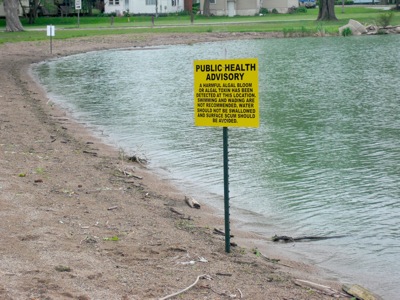Friday, May 20th, 2011
Advisory returns to Grand Lake
By Nancy Allen

Photo by Nancy Allen/The Daily Standard
Public health advisory signs were posted on the three state public beaches on the east side of Grand Lake Thursday afternoon after blue-green algae was detected in the water.
GRAND LAKE - The algae has emerged and so have the warning signs along Grand Lake.
The state Thursday placed the first advisory of the season on the lake after tests earlier this week detected blue-green algae.
"We all knew it was a matter of time; we just didn't know when," said Brian Miller, manager of Grand Lake St. Marys State Park.
The advisory comes almost a full month earlier than the first warning last year. Excessive rainfall in recent weeks has washed a large amount of phosphorous into the lake. The blue-green algae feeds on phosphorous.
Tom Knapke, facilitator of the Lake Restoration Commission this morning said the group wishes the state would have been able to treat the lake with aluminum sulfate this month as was planned.
The state scaled back the treatment and pushed it into June due the excessive rain. Alum binds with phosphorus and makes it unavailable to algae as a food source.
"We were hoping to have the first alum treatment applied first in May then it may have prevented this, but we don't know," Knapke said.
The public health advisory signs were posted at three public beaches on the east side of the lake. They advise people not to swim or wade in the water or swallow it and to avoid surface scum.
Grand Lake's water was cloudy and green Thursday but no scum was visible near the beaches.
Despite the advisory, Knapke said the LRC must keep moving ahead.
"It's an issue we have to deal with, but we have actions that are taking place like rough fish removal and dredging and the alum treatment coming up," he said. "We gotta stay positive and move forward."
Ohio EPA spokeswoman Heidi Griesmer said the public health advisory is due to the presence of algae. It was issued jointly by the Ohio departments of environmental protection, natural resources and health.
The state is no longer using World Health Organization standards to determine advisory levels for algae toxins, Griesmer said. New state standards should be released soon.
"The state has been creating standards ... and is close to finishing those," she said.
Griesmer said the standards will include benchmark levels for different algae toxins that determine when and what type of an advisory is issued.
Tests show the blue-green algae species in the lake is planktothrix, not last year's aphanizomenon which coated the lake in thick, foul-smelling multicolored mats. Aphanizomenon also can produce two other toxins for which there are no standards. The presence of these toxins, one a neurotoxin and the other a liver toxin at any level, last year triggered an automatic advisory. Grand Lake tested positive for both toxins last year.
No toxins have been detected in the city of Celina's treated drinking water, which comes from the lake, said water treatment plant Superintendent Mike Sudman today.
Last summer Grand Lake received the strictest advisory possible, warning people not to boat or eat fish from the lake. The state now says this year it will not advise against boating and that the fish are safe to eat based on new tests.
Griesmer said state remains committed to working with regional partners on improving the water quality of the lake. Efforts by the state include alum testing demonstrations earlier this spring and last year, adding a third dredge and a longer dredging season, rough fish removal, water quality testing and funding for in-stream systems that treat the lake's water.
For updated information, visit the Ohio EPA's Web site at
www.epa.ohio.gov/dsw/HAB.aspx.



